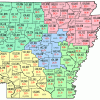calsfoundation@cals.org
Malnutrition
Social, environmental, and political forces have influenced—and often hindered—Arkansans’ access to nutritious food. From outright hunger to nutrient-specific deficiencies like pellagra, malnutrition contributed to stereotypes about “lazy southerners” Through much of the state’s history. The American Mercury’s 1954 description of Arkansas as a land of “malnutrition, mental disability, hookworm, [and] hogs” did little to refute this stereotype. Although nutrition interventions focused heavily on the Delta area by the conclusion of the twentieth century, Arkansas as a whole received the dubious distinction as having the fifth-highest rate of food hardship in the nation of all states in 2012, according to the Food Research and Action Center.
Historical Background
Some of the earliest evidence of malnutrition in what is now Arkansas can be traced to the prehistoric Mississippian Period. Skeletal analysis from the McDuffee excavation site in northeastern Arkansas confirmed nutritional stress, short stature, and earlier mortality—with inadequate nutrition as a contributing factor—in comparison to nearby Mississippian societies.
Although turnip greens occasionally provided vitamins and other essential nutrients for early Arkansans, a typical meal was more likely to include only bread, meat, grease of some kind, and coffee. It was not until settlers from Kentucky, Illinois, and Tennessee moved in the late 1700s and early 1800s to the area that became Arkansas that nutritional variety and farming expanded.
As Arkansas’s agricultural system evolved toward cotton rather than produce, many residents, including slaves, turned to cheap, high-calorie foods such as pork. Foods like potlikker, the left-over broth produced by boiling pork and vegetables, provided only a modest amount of vitamins. Food shortages expanded during the Civil War as soldiers destroyed fences and took livestock, decimating the region’s best source of high-quality protein.
After the war, sharecropper diets mimicked the diet of former slaves, relying heavily on pork, corn meal, lard, molasses, and flour. Although sharecroppers were often allowed small garden plots that provided a modicum of dietary variety through potatoes, collard greens, turnips, okra, beans, and peas, the diet of poor white and black Arkansans remained nutritionally inadequate.
Nutritional Deficiencies
The citizens of Cedar Grove (Lafayette County) represent a notable example of nutritional deficiencies in the black community in the post-Reconstruction period. Excavation and analysis of eighty skeletons revealed a highly stressed and often malnourished population. Common findings included high frequencies of scurvy from vitamin C deficiency, protein malnutrition, rickets (typically associated with inadequate vitamin D), anemia (often caused by—but not exclusive to—iron deficiency), skeletal lesions, and bone porosity (typically caused by inadequate calcium and vitamin D). Bone strength was compromised among males as well as females, an atypical finding.
Disease, poor sanitation, and malnutrition may have acted in concert during this era, worsening the effects of each. Deficiencies in vitamin A, zinc, and iron, for example, increase susceptibility and severity of malaria. Vitamin A deficiency has been demonstrated to increase malaria deaths by about twenty percent. Hookworm, conversely, is a causative agent in nutrient deficiencies such as iron and vitamin A. In an already malnourished population, deficiencies caused by hookworm would be difficult to remedy. Diarrhea resulting from unsafe drinking water depleted minerals in sufferers. Additionally, pica (a.k.a. geophagy)—the habit of consuming dirt, a not uncommon practice in certain regions, including Arkansas—may have contributed to malabsorption of iron and calcium. One of the earliest reported incidences of pica cites “eating dirt” as the cause of death for a seven-year-old African-American girl in Drew County.
Pellagra stands out as the predominant nutritional disease at the turn of the century. Caused by B-3 (niacin) deficiency, pellagra caused victims to display severe lethargy that mimicked that caused by hookworm and malaria. African Americans and women were disproportionately affected. Until the recognition of pellagra as a nutritional disease by Dr. Joseph Goldberger in 1914, sufferers were often ostracized and believed to be contagious. Food shortages in the wake of the Flood of 1927 finally drew awareness to pellagra as a serious nutritional deficiency, but in 1929 alone, 657 Arkansans died from pellagra. Malnutrition was not limited to the Delta, as evidenced by a report of a three family members who reportedly died from malnutrition in Hot Springs (Garland County).
Public health campaigns shifted to promote crop diversification, including niacin-rich green vegetables and grains, as a remedy for pellagra. However, just three years after the devastating Flood of 1927, drought brought massive crop failures to most of the state. Some garden plants such as greens, turnips, and onions survived, but the poorest Arkansans depended on hunting and fishing as their primary food source.
Trends in Hunger Relief
A campaign of self-sufficiency and food autonomy emerged when government servants at multiple levels—from President Herbert Hoover to the Arkansas General Assembly—rejected governmental food relief. The Red Cross provided food rations but no meat, milk, or fresh vegetables, and provisions of niacin-rich flour were often withheld from black sharecroppers. But by 1938, the death rate from pellagra dropped about seventy percent due to increased consumption of niacin-rich yeast flour and green vegetables.
References to outright “starvation in Arkansas” emerged in the 1930s as Arkansas entered the Depression era. But by 1944, Arkansas was home to approximately 40,000 Japanese-American internees and German and Italian prisoners of war (POWs), a circumstance that might have benefited produce production, as POWs were allowed to serve as contract workers on farms. However, laborers typically worked in cotton fields.
The latter half of the twentieth century saw increased government engagement in hunger and nutrition programs. Arkansas’s Board of Health worked to educate consumers, especially mothers and families, by releasing pamphlets like “What to Eat When Prices Are High” in 1960. Nutrition and education programs like Head Start launched in rural counties but struggled to provide services with inadequate availability of medical personnel. One significant nutrition assistance program, the Women, Infants, and Children Special Supplemental Nutrition Program (WIC), began serving Arkansas in 1972, initially serving fourteen Delta counties. By 1979, the program had expanded to all counties, targeting those at high risk of malnutrition and providing nutrition education and “food prescriptions” that targeted nutrition-related deficiencies like anemia, underweight, and short stature.
Attention refocused on the Arkansas Delta as evidence emerged that Delta residents fared far worse nutritionally than their national counterparts. A progression of surveys beginning in the 1990s identified lower intakes of protein, riboflavin, niacin, B-6, B-12, calcium, magnesium, iron, potassium, riboflavin, niacin, vitamin A, carotene, and vitamin C among Delta residents. Black residents were found to consume less vitamin A, C, riboflavin, B-6, calcium, iron, phosphorus, zinc, and copper than Delta whites. One notable concern was a sharp deficit in calcium intake in the Delta, with fewer than twenty percent of Delta adults meeting recommended levels.
Malnutrition in Twenty-First-Century Arkansas
At the dawn of the twenty-first century, inadequate nutrition was still common, with about ten percent of children under five years of age anemic, six percent underweight, and seven percent of short stature. At the same time, public health practitioners were taking note of the problem of “food deserts,” areas with no large supermarket within ten miles. Because of restricted access to fresh fruits and vegetables, residents of food deserts are at a heightened risk of inadequate nutrient intake. Nearly two-thirds of the Delta counties are considered food deserts. Despite Arkansas’s prevalence of food deserts, almost thirty-eight percent of children and adolescents are overweight or obese. This counter-intuitive finding is referred to as the “obesity paradox.” In fact, counties considered food deserts often rank highest in obesity rates due to low availability of fresh produce, reliance on high-calorie processed foods, and complex sociological factors.
Several events in the first decade of the twenty-first century reflect a heightened awareness of and interest in alleviating hunger and malnutrition in Arkansas. With the passage of Act 1220 of 2003, Arkansas legislators dedicated funding and personnel to provide nutrition and physical activity assistance for school children to help curb the trend of “overfed but malnourished” children. In 2004, the Arkansas Hunger Relief Alliance formed with the goal of reducing hunger through school food programs and community assistance initiatives. By 2007, the Arkansas General Assembly had formed the first state legislative hunger caucus in the nation, and, in 2009, Arkansas was chosen by the national nonprofit Share Our Strength as a “concept state” for reducing childhood hunger. This led to the creation of the No Kid Hungry campaign, a public-private partnership. This partnership addressed food insecurity by providing meal programs while teaching healthier cooking techniques and food selection through cooking and shopping education programs.
For additional information:
Arkansas Hunger Relief Alliance. http://www.arhungeralliance.org (accessed October 13, 2021).
Bolton, Conevery A. “‘A Sister’s Consolation’: Women, Health, and Community in Early Arkansas.” Arkansas Historical Quarterly 50 (Autumn 1991): 271–291.
Champagne, Catherine M., et al. “Dietary Intake in the Lower Mississippi Delta Region: Results from the Foods of Our Delta Study.” Journal of the American Dietetic Association 104 (February 2004): 199–207.
Downs, William D., Jr. Stories of Survival: Arkansas Farmers during the Great Depression. Fayetteville, AR: Phoenix International, 2011.
Finley, Randy. “In War’s Wake: Health Care and Arkansas Freedmen, 1863–1868.” Arkansas Historical Quarterly 51 (Summer 1992): 135–163.
Food Research and Action Center. http://frac.org/ (accessed October 13, 2021).
Ghalib, Diane E. “Subadult Health in a Northeastern Arkansas Middle Mississippian Site.” Arkansas Archeologist 38 (1997): 69.
Lambert, Roger. “Hoover and the Red Cross in the Arkansas Drought of 1930.” Arkansas Historical Quarterly 29 (Spring 1970): 3–19.
Martin, D. L., A. L. Magennis, and J. C. Rose. “Cortical Bone Maintenance in an Historic Afro-American Cemetery Sample from Cedar Grove, Arkansas.” American Journal of Physical Anthropology 74 (October 1987): 255–264.
“Rural Profile of Arkansas 2011.” University of Arkansas Division of Agriculture. http://www.uaex.edu/Other_Areas/publications/PDF/mp474.pdf (accessed October 13, 2021).
Stuff, G. E., et al. “High Prevalence of Food Insecurity and Hunger in Households in the Rural Lower Mississippi Delta: The Lower Mississippi Delta Nutrition Intervention Research Consortium” Journal of Rural Health 20 (Spring 2004): 173–180.
Thompson, Emily. “The Stigmatization of Hunger: The Impact of Social Stigma on Arkansas Youths’ Food Security.” MA thesis, University of Arkansas, 2020. Online at https://scholarworks.uark.edu/etd/3707/ (accessed July 6, 2022).
Upton, Elsie. “A History of Newton County Health Department.” On file at Arkansas Department of Health, Little Rock, Arkansas.
Webb, Kathy, and Bonnie Allen. “Southern Progress: Antihunger and Food Justice Movements in Arkansas and Mississippi.” Clearinghouse Review: Journal of Poverty Law and Policy 45 (September–October 2012).
Woodruff, Nan Elizabeth. As Rare as Rain: Federal Relief in the Great Southern Drought of 1930–31. Urbana: University of Illinois Press, 1985.
Christine McKnelly
Conway, Arkansas
 Arkansas Department of Health (ADH)
Arkansas Department of Health (ADH) England Food Riot of 1931
England Food Riot of 1931 Mental Health
Mental Health Poverty
Poverty Rickets Victim
Rickets Victim 




Comments
No comments on this entry yet.